Résumés
Abstract
This article examines the evolution of business research through the cross-disciplinary dissemination of business knowledge. Drawing on social network analysis techniques, we explain how knowledge flows through citation networks cross-disciplinary boundaries; and we identify the role of core journals in that evolution. The empirical analysis is based on 4.58 million citations by 105,405 papers published in 252 journals between 1990 and 2010. Three important findings emerge from this analysis: (1) increased knowledge connections among disciplines, (2) changing influences of certain journals within and across disciplines, and (3) a few journals bridge multiple disciplines.
Keywords:
- Business scholarship,
- citation networks,
- sociometric analysis,
- bridging journals
Résumé
Cet article examine l’évolution de la recherche en commerce à travers la diffusion interdisciplinaire des connaissances commerciales. En s’appuyant sur des techniques d’analyse des réseaux sociaux, nous expliquons comment les flux de connaissances à travers les réseaux de citations traversent les frontières disciplinaires, et nous identifions le rôle des revues principales dans cette évolution. L’analyse empirique est basée sur 4,58 millions de références citées dans 105 405 articles publiés dans 252 revues entre 1990 et 2010. Trois constats importants émergent de cette analyse: (1) des liens de connaissances accrus entre les disciplines, (2) des influences changeantes de certaines revues au sein et à travers les disciplines, et (3) peu de revues relient plusieurs disciplines.
Mots-clés :
- Recherche en commerce,
- réseaux de citations,
- analyse sociométrique,
- revues transitoires
Resumen
Este artículo examina la evolución de la investigación en comercio a través de la difusión interdisciplinaria de los conocimientos comerciales. Utilizando técnicas de análisis de las redes sociales, explicamos cómo los flujos de conocimientos a través de las redes de citas, superan los límites de las disciplinas, e identificamos el papel de las revistas líderes en esta evolución. El análisis empírico se basa en 4,58 millones de referencias citadas en 105405 artículos publicados en 252 revistas entre 1990 y 2010. Tres importantes conclusiones surgen de este análisis: 1) el aumento de los vínculos de conocimiento entre las disciplinas, 2) las influencias cambiantes de algunas revistas dentro de las disciplinas y a través de estas, y 3) pocas revistas vinculan varias disciplinas.
Palabras clave:
- Investigación en comercio,
- redes de citas,
- análisis sociométrico,
- revistas transitorias,
- redes de citas
Corps de l’article
Developments in business scholarship have created a situation in which academic conversations tend to be structured predominantly around a few core journals that represent specific associations or research areas (Vogel, 2012). Many academic domains follow a conventional evolution as they mature, becoming more specialized and structured into homogenous communities (Knorr-Cetina, 1999). In particular, academic disciplines emerge when a community of scholars, who interact intensively, begins to address unsolved questions by establishing a unique knowledge set and analytical toolkit (Colquitt and Zapata-Phelan, 2007). They formulate questions of interest, then create unique sets of theories, methodologies, and communication styles. Journals constitute a key channel for their interaction, and they also reinforce the strength of the intellectual climate that arises. Through this process, journals co-evolve, interrelate, and mutually reinforce one another, thereby strengthening the specification and maturation of a research discipline further (Augier et al., 2005).
In particular, citations in journal articles serve to disseminate knowledge, sometimes across related disciplines. Therefore, knowledge flows and evolutions in business scholarship arguably can be understood by examining patterns of citations across journals (Podsakoff et al., 2005). Existing studies consider the role of journals and flows of knowledge, usually within specific business disciplines, such as behavioral science (Extejt and Smith, 1990), strategic management (Nerur et al., 2008; Ramos-Rodriguez and Ruaz-Navarro, 2004), supply chain management (Carter et al., 2007), or organization studies (Augier et al., 2005; Daft and Lewin, 2008; Vogel, 2012). However, knowledge flows across disciplines, spanning business scholarship more widely, have not been explored as closely (Agarwal and Hoetker, 2007).
In response to calls to investigate mutual knowledge flows across research disciplines (e.g., Agarwal and Hoetker, 2007), we explore networks among disciplines and the dynamics of knowledge flows across the evolution of business scholarship. To frame this effort, we focus on two main research questions. First, at the journal level, how does the influence exerted by core, or the most cited, journals evolve within their own discipline and in relation to other disciplines? Second, at the discipline level, how do knowledge connections across business disciplines evolve over time? We analyze a longitudinal data set of 4.58 million citations in 105,405 papers, published in 252 core business journals. With this detailed analysis of cross-disciplinary knowledge flows in business research, we issue a challenge to the conventional wisdom that implies business education and research are becoming more specialized and fragmented (Rafols et al., 2012; Walsh et al., 2017); instead, we observe that knowledge connections increase over time. That is, articles published in core journals receive more citations by researchers in other disciplines over time. Several bridging journals also connect multiple disciplines, and we can categorize them according to their roles in knowledge flow networks.
Theoretical Background
Growth in scientific fields can be modeled as a competitive process (Callon, 1994) or defined by the pattern of coherent behaviors exhibited by scientists who have grouped together within “invisible” colleges (Crane, 1972). Scientists in the same field share a research agenda and establish research avenues and questions in similar ways. These scientific fields in turn are delineated by journals, conferences, and training curricula that lead to the institutionalization of the discipline (Lockett and McWilliams, 2005). As a field becomes established, its community grows and explores specialized questions, generating new subfields and new research questions as disciplinary foundations (van Baalen and Karsten, 2012).
These disciplines may be more independent or interrelated, such that they refer to or share knowledge; each discipline navigates between these poles. Gulati (2007, p. 775) argues that business scholarship research, journals, and programs operate in silos, “sequestrating themselves into closed loops of scholarship dismissing the work of outsiders on the basis of their inclusion—or exclusion—of theory or of practical applications,” which conflicts with ongoing calls for interdisciplinary research (Bennis and O’Toole, 2005; Dunning, 1989). Many business problems are multidimensional, such that they require integrated knowledge across disciplinary boundaries, and business executives often emphasize the interdisciplinary nature of their profession and the need for conversation among scholars representing different disciplines (Bennis and O’Toole, 2005).
Accordingly, some scholars have sought knowledge connections across disciplinary boundaries (Daft and Lewin, 2008), as well as studied structures and communications by disciplines, through knowledge flows (Lockett and McWillians, 2005; Nerur et al., 2008; Ramos-Rodriguez and Ruiz-Navarro, 2004). That is, to generate ideas within their domain, scholars increasingly seek ideas from neighboring disciplines, and some journals bridge multiple disciplines in an attempt to spread such knowledge. They seek to publish generalizable concepts and mechanisms, so the citation patterns of articles in these journals likely map knowledge flows across the disciplines and signal knowledge spreading over time (Golden-Biddle et al., 2006). We seek to track cross-discipline knowledge spreading, according to citations in journal articles, by analyzing core journals’ influence within and across disciplines. In so doing, we can identify bridging journals, positioned at the network intersection of two or more disciplines.
Method
Data
As noted, to explore the structure of business scholarship, we focus on knowledge flows within and between research disciplines, in line with the rich tradition of citation analysis used to study the cumulative process of scientific knowledge production (e.g., Agarwal and Hoetker, 2007; Johnson and Podsakoff, 1994). Citations provide a proxy for intellectual conversations among authors and reflect the extent to which each article draws from the stock of knowledge available in the cited works (Podsakoff et al., 2005). We obtained data from the “Web of Science” (WoS) database, published by the Institute for Scientific Information (ISI), for three categories: management, business, and business and finance. The database contains detailed information about articles published in peer-reviewed journals, including author names, titles, year of publication, journal name, and, of particular interest to us, the full reference list. For the years 1990–2010, we review 252 business-related journals, which published 105,405 articles that contained 4.58 million citations.
Journal Categorization
To determine whether business scholarship is a single, integrated field or comprises multiple disciplines, we analyzed the citation pattern of the 252 journals using a hierarchical clustering algorithm (Johnson, 1967) in Ucinet 6 (Borgatti et al., 2002). This algorithm starts by placing all the journals in different clusters, then joins together any two journals that are closest, meaning that they cite each other the most often. These two journals are then combined into a single entity. The algorithm next identifies a journal that is most similar to this combined entity and joins it to the cluster. If two journals are more similar to each other than to the original cluster, they form a new cluster. The algorithm continues until all journals have joined a cluster. We ran this hierarchical clustering algorithm for the 252 journals for each of the 21 years of the data and for all years combined. In all cases, the most prominent categorization showed four distinct clusters, representing four research disciplines: management, finance, marketing, and operations research/management information systems.
Table 1
Descriptive Statistics of Business Journals, Articles and Citations (1990–2010)
Table 1 details the descriptive analysis of the journal categories. The number of journals per category is not equal; finance (82) and management (81) include more journals than operations (46) or marketing (43). Notably, the management discipline features disproportionally more citations per article than the other three disciplines. Although 40% of citations pertain to business scholarship journals, this proportion differs by discipline. For example, operations (30%) shows a considerably lower rate than finance (48%), implying that finance is more self-contained within business scholarship than operations is.
Network Analysis
We adopted the social network approach (Wasserman and Faust, 1994) for the citation analysis. A social network contains multiple social actors, connected via relationships. For our analysis, the actor is the journal or discipline, and the relationship is the citation linkage. The citation relationship is directional, from the cited to the citing journal, reflecting the direction of the flow of ideas and knowledge. Then the number of citations indicates the strength of the linkage, defined by the amount of knowledge and ideas flowing. In Ucinet 6 (Borgatti et al., 2002), we analyzed 1,846,395 citations among 252 business journals by creating a 252´252 journal-citing-by-journal-cited network for each year, as well as an aggregated network covering the full 21-year period. By manipulating the journal citation matrix and the journals’ discipline affiliation, we also created two additional matrices for each year and for all 21 years, producing a journal-cited-by-discipline network (252´4 matrix) and a discipline-cited-by-discipline network (4x4 matrix).
E-I Index
To measure each journal’s ratio of internal to external influence, we used an E-I index (Krackhardt and Stern, 1988), or the proportion of the difference between the journal’s external and internal citations, divided by the total number of citations:
where E is external citations (received from journals in other disciplines), and I is internal citations (from journals in the same discipline). For each journal, the E-I index ranges from -1 to 1. A higher value means the journal was cited more by journals in other disciplines, such that it has a greater overall influence on the rest of the business field.
Degree Centrality
We use the concept of degree centrality to measure a journal’s influence within its own discipline (Freeman, 1979). A greater value for this network measure indicates that more articles in that journal get cited within the discipline. For comparisons across disciplines, we calculate the normalized degree centrality (Ci), which presents the value as a fraction of a node’s maximum possible value n – 1, so it is independent of the size of the discipline:
where xij is the number of articles in journal i being cited by articles in journal j, and n is the number of journals in the discipline.
Results
Journals’ Internal and External Influences
In our analysis, we focus on 12 journals in each discipline that record the highest number of citations. Figure 1, Panels a–d, illustrates the within- and across-discipline influence of the 12 top journals in each discipline. We use the within-discipline normalized centrality measure (Ci) as the X-coordinate and the cross-discipline influence (E-I index) as the Y-coordinate.
According to Figure 1a, the most cited journals in the finance discipline, Journal of Financial Economics and Journal of Finance, achieve relatively low E-I index scores; they are not frequently cited outside of finance. Rather, the more economics-oriented journals (e.g., American Economic Review, Quarterly Journal of Economics, Review of Economics and Statistics) appear more influential outside of this discipline.
In Figure 1b, we detail the 12 top cited management journals, which appear rather more closely grouped, such that those that collectively lead management research and constitute the theoretical “front line” are also the most prominent (Academy of Management Journal, Academy of Management Review, Journal of Applied Psychology, and Strategic Management Journal). Journals with high ratios of citations from outside the discipline include Strategic Management Journal, Organization Science, and Psychological Bulletin. Notably then, Strategic Management Journal is both centrally located within the management discipline and frequently used as a source of knowledge by other disciplines.
The marketing journals in Figure 1c follow a pattern that is somewhat similar to that for the finance journals. Three journals clearly constitute the core of the discipline: Journal of Consumer Research, Marketing Research, and Journal of Marketing. Three other journals have the highest ratios of citations outside of marketing: Journal of Product Innovation Management, Psychological Review, and Journal of Personal Social Psychology. These bridging journals attain E-I index scores that are above or very close to 0.
Figure 1a
Top Finance Journals’ Influence Within and Across Subfields (1990–2010)
Figure 1b
Top Management Journals’ Influence Within and Across Subfields (1990–2010)
Figure 1c
Top Marketing Journals’ Influence Within and Across Subfields (1990–2010)
Figure 1d
Top Operations Journals’ Influence Within and Across Subfields (1990–2010)
Finally, in Figure 1d, we denote operations journals. Management Science is in a unique position: the most dominant journal in the discipline that also has a high ratio of external to internal citations. Research Policy is also relatively dominant within the discipline. Two practice-oriented journals, Harvard Business Review and California Management Review, along with Long Range Planning, have high E-I index scores, so they are clearly bridging journals.
Dynamics of Journals’ Influence
To explore the dynamics of the top journals’ influence and their bridging roles, we split the 21-year study period into three 7-year periods: 1990–1996, 1997–2003, and 2004–2010. For simplicity and a clearer contrast, we do not include data for the second period in any of the panels in Figure 2. In Panel a, we depict the changes in within- and cross-discipline influences of the 12 most cited finance journals. The most notable change appears for the two dominant within-field journals (Journal of Finance and Journal of Financial Economics), for which their influence increased.
Figure 2b shows the changes for the top 12 management journals. Overall, management’s cross-discipline influence increased over time, with the exception of a small decrease in the E-I value for Journal of International Business. Instead, Strategic Management Journal, Administrative Science Quarterly, Organization Science, Psychological Bulletin, and Journal of Management recorded notable increases in their cross-discipline influences; during the 21-year period, researchers in other areas consulted management research more frequently for new ideas and knowledge. Yet at the same time, the within-discipline centrality of 6 of the 12 journals decreased, including substantial decreases registered by Academy of Management Review, Academy of Management Journal, Journal of Applied Psychology, and Psychological Bulletin. This trend signifies broadening in the sources of knowledge flows in the management discipline; accordingly, other journals within the discipline gained ground relative to these incumbent top journals. The only journal with a notable increase in within-discipline centrality was Organization Science, which has gained prominence in the discipline since it first started publishing in 1990.
According to the trends for marketing journals in Figure 2c, Journal of Marketing, Journal of Marketing Research, and Journal of Consumer Research increased their dominance; Psychological Review and Journal of Personality and Social Psychology, which previously revealed a high external-to-internal citation ratio, experienced decreases in their E-I index scores. Overall, the marketing discipline appears to have grown even more centralized, around a few core journals.
Figure 2a
Dynamics of Finance Journals Within and Across Subfields (1990–2010)
Figure 2b
Dynamics of Management Journals Within and Across Subfields (1990–2010)
Figure 2c
Dynamics of Marketing Journals Within and Across Subfields (1990–2010)
Figure 2d
Dynamics of Operations Journals Within and Across Subfields (1990–2010)
Finally, the changes in the operations discipline in Figure 2d indicate a greater within-discipline influence of Management Science, along with Research Policy. With regard to being cited outside their discipline, we find notable increases for MIS Quarterly and Long Range Planning.
Dynamics of Bridging Journals
Bridging journals connect multiple disciplines. We created two network diagrams to depict which journals had important bridging roles during 1990–1996 (Figure 3a) and then during 2004–2010 (Figure 3b), to identify any notable changes. Black circles indicate the journals; grey squares are the business disciplines. Thus, a line between a journal and a discipline indicates the journal provided more than 2% of the references to the discipline. Bridging journals provide strong knowledge support to more than one discipline simultaneously.
In 1990–1996, no journals bridged finance with other disciplines. Both Harvard Business Review and Management Science bridged across management, marketing, and operations. Although these two journals publish different styles of articles, they have similar bridging roles in connecting the three disciplines. The only other journal to bridge disciplines is the Journal of Personality and Social Psychology, which connects management and marketing. The bridges in 2004–2010 exhibit a more complex structure though. Finance is still isolated, yet Journal of Marketing now bridges between marketing and management (together with Management Science and Harvard Business Review), and Academy of Management Journal, Academy of Management Review, Organization Science, and Administrative Science Quarterly provide bridges between management and operations. Journal of Personality and Social Psychology maintains its role, bridging between management and marketing. The increasing number of management journals that link to marketing or operations is notable. Finally, reflecting its growing influence throughout the business scholarship field, Strategic Management Journal bridges across management, operations, and marketing.
Figure 3a
Bridging Journals and the Connectedness of Business Subfields (1990–1996)
Figure 3b
Bridging Journals and the Connectedness of Business Subfields (2004–2010)
Discussion
Increased Knowledge Connections Across Disciplines
In both classrooms and research labs, business-related academia tends to be segmented (Walsh et al, 2017), such that business schools rely on departmentalized structures and separate major disciplines such as finance, management, strategy, and marketing. In each discipline, researchers explore specialized questions, generate new ideas, and develop research agendas derived from distinct theoretical foundations. The specific conversations that take place among the focused audiences strengthen a domain’s internal legitimacy, especially with intensive citations of publications in core journals (Lockett and McWilliams, 2005). But real-world business questions tend to be multidimensional, requiring knowledge from various research domains to find answers and solutions. Thus both academics and executives acknowledge the interdisciplinary nature of business professions and suggest that scholars from different research domains need to engage in more conversations (Bennis and O’Toole, 2005). Our analysis indicates that such calls have been effective; rather than finding fragmented business scholarship (Rafols et al., 2012), we observe increasing knowledge connections across business research disciplines. As Figure 2, Panels a–d, reveals, 38 of the 48 core journals in the four disciplines demonstrate increasing E-I values, that is, greater ratios of citations from other disciplines. We also find increasing numbers of bridging journals, from three to nine, in our analysis window (Figure 3), which represents the increasing connections across business research disciplines. Researchers increasingly consult studies in other disciplines, seeking supports and new ideas; they combine knowledge from multiple disciplines to generate solutions for emerging business problems or advance theoretical developments.
Bridging Journals
We identify nine bridging journals that connect multiple research disciplines. Despite their roots in a specific discipline, these bridging journals publish articles with generalizable concepts or theories that can cross-fertilize multiple disciplines. In reviewing the mission statements of these journals, we note some key similarities in their stated objectives, such that their underlying mission is to facilitate the dissemination of research outcomes within and across disciplinary boundaries. However, the journals exhibit different approaches to reaching such objectives, as displayed by the keywords in their mission statements, the types of articles and studies they publish, and the patterns by which they connect multiple disciplines. We thus classify three main types of bridging journals: builders, consolidators, and connectors.
Theory and Method Builders
In their review of 25 years of citations of Academy of Management Journal, as a representative of management discipline, Agarwal and Hoetker (2007) reveal that its evolution has resulted from significant input from sociology, psychology, and economics, which also constitute underlying disciplines for management (Gorden and Howell, 1959). Management relies on them for content and theories, as well as for methods and intellectual rigor. Four bridging journals are particularly closely connected to these underlying disciplines; they also speak to a broad audience. Administrative Science Quarterly aims to publish organizational and management research from a wide range of disciplines, including sociology, psychology, organizational theory, strategic management, economics, public administration, and so forth. Journal of Personality and Social Psychology proclaims that it publishes original papers in all areas related to personality and social psychology, which in turn are extensively cited by both management and marketing researchers. Management Science encompasses a wide range of management topics and emphasizes the creativity of new ideas, theoretical perspectives, and methods, as well as methodological rigor. Many articles it publishes rely on econometrics, formal modeling, game theory, or sophisticated mathematical tools. Finally, Academy of Management Review also speaks to a broad audience, and it defines its main mission as a generator of fresh conceptual theories that significantly challenge existing management and organizational theories. These four bridging journals thereby address fundamental management research questions and derive new concepts and models, which in turn nourish multiple research disciplines.
Theory and Method Consolidators
Another type of bridging journal focuses on testing and extending general concepts, theories, and methods whose influence and applicability are broad. For example, in the management discipline, Academy of Management Journal, Strategic Management Journal, and Organization Science have published impactful articles related to the resource-based view of the firm, knowledge management, open innovation, and absorptive capacity. Such concepts are widely applicable in studies of strategy, entrepreneurship, international business, or operations management. These journals also advance disciplinary knowledge and balance relevance with rigor. Similarly, Journal of Marketing has these characteristics and also is extensively cited by research in both marketing and operations.
Academia–Practitioner Connectors
Finally, some of the previously noted bridging journals cite bringing scholars and practitioners together as a main objective, but Harvard Business Review remains the primary reference, as the established standard for practice-oriented business journals. Its problem-solving orientation means that it seeks articles that mobilize concepts and solutions from a wide range of scholarship. Moreover, it focuses on relevance, sense-making, and tools to assist business managers in finding solutions. Consequently, many researchers in various disciplines take inspiration, absorb ideas, and get support from conversations initiated by Harvard Business Review, which relate closely to emerging business problems and their solutions.
Conclusion
With vast samples of journals, articles, and citations, we present a picture of business scholarship and demonstrate that it has created increasing connections among its disciplines over time. Substantial debate has focused on the relevance versus rigor debate (Gulati, 2007), but research efforts have tended to rely on single business disciplines or single journals. This study attempts to broaden the focus by looking at the evolution of the entire field over a 21-year period. With a citation analysis, we construct a business scholarship network of four disciplines, and we record interconnected knowledge structures across this network. The analysis reveals the growing connectivity in business disciplines and the critical role of bridging journals in fostering conversations across business disciplines.
Continued research could go further in examining knowledge networks in business scholarship from other perspectives. For example, we identify knowledge connections among disciplines and bridging journals by considering the journals’ out-degree connections in the citation network, that is, the outbound knowledge flow to other journals and disciplines. By analyzing in-degree links, researchers might track sources of inbound knowledge flows and potentially present another interesting facet to describe knowledge networking in business scholarship. Another option might be to develop a co-authorship network of impactful papers and examine collaborations among researchers from different disciplinary backgrounds, which could provide a novel means to explore cross-disciplinary collaboration and reveal knowledge interactions at a different, authorship level.
Parties annexes
Bibliography
- Agarwal, R., Hoetker, G. (2007). “A Faustian bargain? The growth of management and its relationship with related disciplines,” Academy of Management Journal, 50, p. 1304-1322.
- Augier, M., March, J.G., Sullivan, B. N. (2005). “Notes on the evolution of research communities: Organization studies in anglophone North America, 1945–2000,” Organization Science, 16(1), p. 85-95.
- Bennis, W. G., O’Toole, J. (2005). “How business schools lost their way,” Harvard Business Review, 83, p. 96-104.
- Borgatti, S. P., Everett, M. G., Freeman, L. C. (2002). Ucinet for Windows: Software for social network analysis. Harvard, MA: Analytic Technologies.
- Callon, M. (1994). “Four models for the dynamics of science,” In S. Jasanoff, G. E. Markle, J. C. Petersen, T. Pinch, (Eds.), Handbook of science and technology studies. Los Angeles, CA: Sage.
- Carter, C.R., Leuschner, R., Rogers, D.S., (2007). “A social network analysis of the Journal of Supply Chain Management: Knowledge generation, knowledge diffusion and thought leadership,” Journal of Supply Chain Management, 43(2), p. 15-28.
- Colquitt, J.A., Zapata-Phelan, C.P. (2007). “Trends in theory building and theory testing: A five-decade study of the Academy of Management Journal,” Academy of Management Journal, 50, p. 1281-1303.
- Crane, D. (1972). The invisible college. Chicago: University of Chicago Press.
- Daft, R., Lewin, D. (2008). “Rigor and relevance in organisation studies: Idea migration and academic journal evolution,” Organization Science, 19: 1, p. 177-183.
- Dunning, J. H. (1989). “The study of international business: a plea for a more interdisciplinary approach,” Journal of International Business Studies, 20, p. 411-436.
- Extejt, M. M., Smith, J. E. (1990). “The behavioral sciences and management: An evaluation of relevant journals,” Journal of Management, 16, p. 539-551.
- Freeman, L. C. (1979). “Centrality in social networks: conceptual clarification”. Social Networks, 1, p. 215-239.
- Golden-Biddle, K., Locke, K., Reay, T. (2006). “Using knowledge in management studies: An investigation of how we cite prior work,” Journal of Management Inquiry, 15(3), p. 237-254.
- Gordon, R. A., Howell, J. E. (1959). Higher education for business. New York: Columbia University Press.
- Gulati, R. (2007). “Tent poles, tribalism and boundary spanning: The rigor-relevance debate in management research,” Academy of Management Journal, 50, p. 775-782.
- Johnson, J. L., Podsakoff, P. M. (1994). “Journal influence in the field of management: An analysis using Salancik’s index in a dependency network,” Academy of Management Journal, 37, p. 1392-1407.
- Johnson, S.C. (1967). “Hierarchical clustering schemes,” Psychometrika, 32, p. 241-253.
- Knorr-Cetina, K. (1999). Epistemic cultures: How the sciences make knowledge. Cambridge, MA: Harvard University Press.
- Krackhardt, D., Stern, R.N. (1988). “Informal networks and organizational crises: An experimental simulation,” Social Psychology Quarterly, 51(2), p. 123-140.
- Lockett, A., McWillians, A. (2005). “The balance of trade between disciplines. Do we effectively manage knowledge?” Journal of Management Inquiry, 14(2), p. 139-150.
- Nerur, S.P., Rosheed, A.A., Natarajan, V. (2008). “The intellectual strucutre of the strategic management field: An author co-citations analysis,” Strategic Management Journal, 29(3), p. 319-326.
- Podsakoff, P. M., MacKenzie, S. B., Bachrach, D. G., Podsakoff, N. P. (2005). “The influence of management journals in the 1980s and 1990s,” Strategic Management Journal, 26(5), p. 473-488.
- Rafols, I., Leydesdorff, L., O’Hare, A., Nightingale, P., Stirling, A. (2012). “How journal rankings can suppress interdisciplinary research: A comparison between innovation studies and business management,” Research Policy, 41, p. 1262-1282.
- Ramos-Rodriguez, A. R., Ruaz-Navarro, J. (2004). “Changes in the intellectual structure of strategic management research: A bibliometric study of the Strategic Management Journal (1980–2000).” Strategic Management Journal, 25(10), p. 981-1004.
- van Baalen, P., Karsten L. (2012). “The evolution of management as an interdisciplinary field,” Journal of Management History, 18, p. 218-237.
- Vogel, R. (2012). “The visible colleges of management and organization Studies: A bibliometric analysis of academic journals”. Organization Studies, 33, p. 1015-1043.
- Walsh, S., Yan, J., Mangematin, V., Mei, M., (2017) “Paper bastions: Architecting academic citadels from 1992 to 2011,” Management International, 4, p. 126-135.
- Wasserman, S., Faust, K. (1994). Social Network Analysis. Cambridge, UK: Cambridge University Press.
Liste des figures
Figure 1a
Top Finance Journals’ Influence Within and Across Subfields (1990–2010)
Figure 1b
Top Management Journals’ Influence Within and Across Subfields (1990–2010)
Figure 1c
Top Marketing Journals’ Influence Within and Across Subfields (1990–2010)
Figure 1d
Top Operations Journals’ Influence Within and Across Subfields (1990–2010)
Figure 2a
Dynamics of Finance Journals Within and Across Subfields (1990–2010)
Figure 2b
Dynamics of Management Journals Within and Across Subfields (1990–2010)
Figure 2c
Dynamics of Marketing Journals Within and Across Subfields (1990–2010)
Figure 2d
Dynamics of Operations Journals Within and Across Subfields (1990–2010)
Figure 3a
Bridging Journals and the Connectedness of Business Subfields (1990–1996)
Figure 3b
Bridging Journals and the Connectedness of Business Subfields (2004–2010)
Liste des tableaux
Table 1
Descriptive Statistics of Business Journals, Articles and Citations (1990–2010)




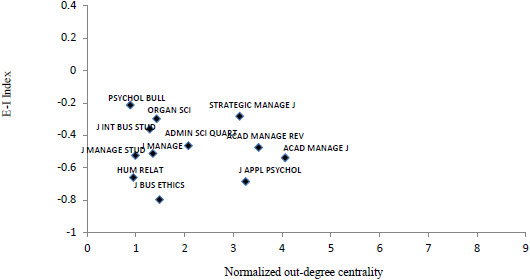

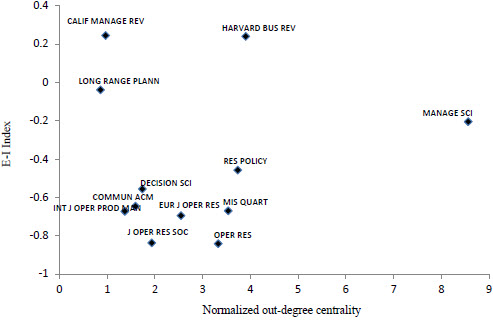


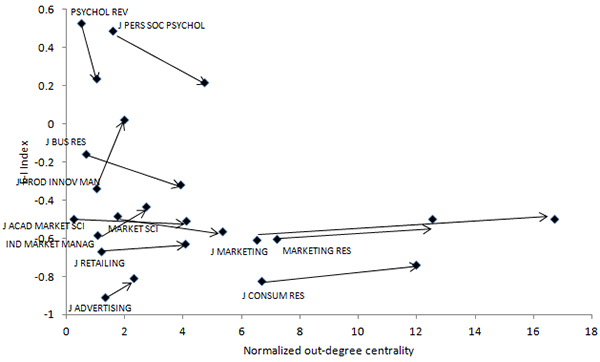
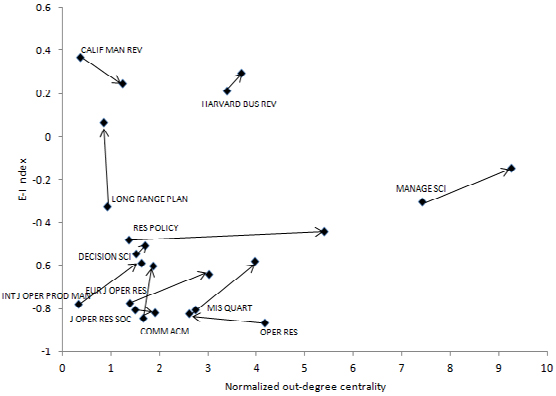
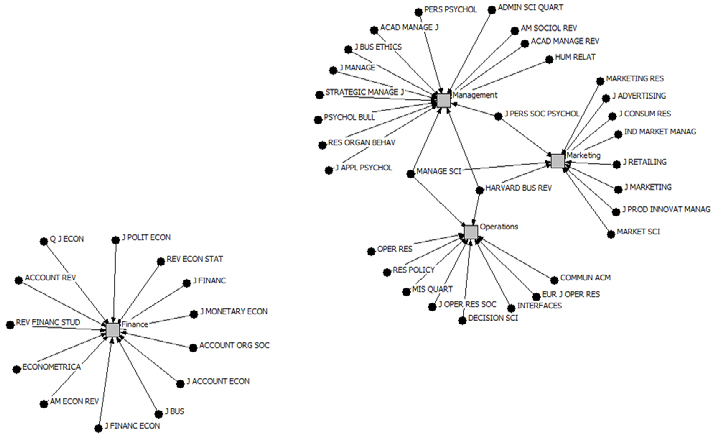
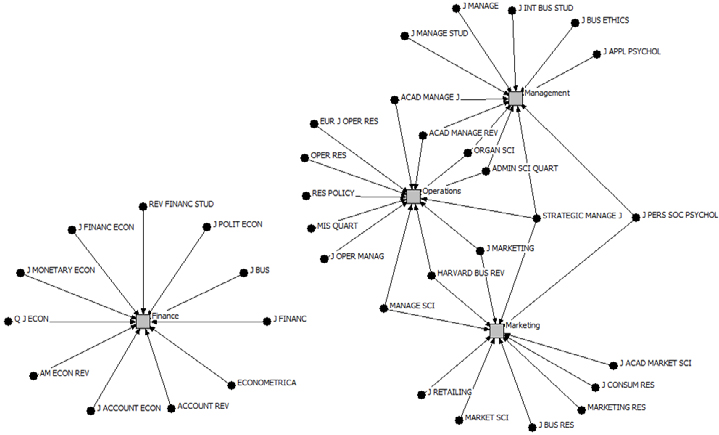
 10.7202/1053582ar
10.7202/1053582ar